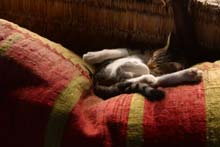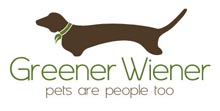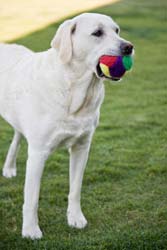Pet Obesity is Now the Leading Cause of
Preventable Death in Dogs and Cats
by www.SixWise.com
Over 44 percent of dogs and 57 percent of cats are overweight or obese, according to the Association for Pet Obesity Prevention (APOP). These shocking figures confirm that the United States is indeed facing a pet obesity epidemic, one that is putting a large number of pets at unnecessary risk for chronic illness and premature death.
|
Want to Give Your Pet the Longest, Healthiest, Happiest Life Possible?

Choose healthy, natural pet food and treats from GreenerWiener.com!
At Greener Wiener their mission is simple: to provide natural pet products that promote wellness for dogs and cats.
Greener Wiener believes your pets deserve healthy food and treats, and toys made from non-toxic materials. They believe the Earth deserves a break too, which is why they actively seek out products made from safe, environmentally friendly materials.
Visit GreenerWiener.com now to view their unique line of all-natural pet products to enhance the health and well-being of your furry little ones.

|
In fact, pet obesity has now emerged as the leading cause of preventable death in dogs and cats.
"Pet obesity continues to emerge as a leading cause of preventable disease and death in dogs and cats. Our pets are in real danger of not living as long as previous generations and developing serious and costly diseases such as diabetes, arthritis, and other largely avoidable conditions,” said Dr. Ernie Ward, the lead researcher in the second annual National Pet Obesity Day Study.
The study, which was conducted in October 2008 and involved 669 dogs and 202 cats, found that from 2007 to 2008 overweight dogs and cats increased by 1 percent and 4 percent, respectively. Further, the study found:
In all, this means that 7.2 million dogs are estimated to be obese and 26 million overweight. The numbers for cats came in even higher, with an estimated 15.7 million obese and 35 million overweight.
"These numbers, 33 million dogs and 51 million cats that are overweight, represent a huge problem for everyone. Excess weight causes or contributes to many painful and debilitating conditions. Just as we’ve become a nation of couch potatoes, our pets have become a nation of lap potatoes -- and that’s not good for anyone,” Dr. Ward said in an APOP press release.
While any pet can become overweight, older pets and smaller breed dogs were at a higher risk of becoming overweight. Over 52 percent of dogs and 55 percent of cats over the age of 7 were found to be overweight or obese.
Small breed dogs such as dachshunds, Chihuahuas, and Yorkshire terriers were also more likely to be classified as overweight than Labrador retrievers, Golden retrievers and German shepherds.
Health Risks for Overweight and Obese Pets
As in humans, excess weight can increase the risk for a wide array of health problems in dogs and cats -- health problems that otherwise may be avoidable.
“Extra pounds in older pets amplify any pre-existing conditions and complicate treatment. We’re seeing more and more diabetes, respiratory, and arthritic conditions in older pets as a direct result of obesity. These are often chronic, incurable, and generally preventable diseases. Pet owners need to understand that a few extra pounds on a dog or cat is similar to a person being 30 to 50 pounds overweight,” Dr. Ward says.
According to APOP, common health risks of obesity in pets include:
How to Determine if Your Pet is Overweight: The At-Home Pet Weight Check
If you’re not sure whether or not your pet is at a healthy weight, a trip to your veterinarian will let you know for sure. However, APOP has listed a few signs to look for that you can check right in your own home.
Pet Weight Check
Your Pet is Overweight if …
|

A special toy may be just the thing to get your pooch off the couch and active again.
|
Your pet may be overweight without your even knowing it, as The American Animal Hospital Association pet owner survey reported that only 17 percent of pet owners rated their pets as overweight, while veterinarians estimated that 44 percent of their patients were too heavy.
Why are So Many Pets Overweight?
As in humans, pets often become overweight due to poor diet, overeating and lack of activity.
"Pet obesity begins with excessive kindness," said Dr. Carol McConnell, vice president and chief veterinary officer for VPI in a press release. "Food is the primary way some pet owners demonstrate love to their pet. When dog treats and table scraps become signs of affection or behavioral tools, it becomes difficult to effectively regulate a pet's diet."
Further, most indoor cats, and many dogs, do not receive much physical activity during the day.
“Smaller, indoor-only dogs tend to have more trouble maintaining a healthy weight because they don’t get adequate exercise. Unfortunately, these are also the dogs we’re seeing a high number of weight-related disorders in,” says Dr. Ward.
Is Your Pet’s Food Making Him Fat?
Many commercial pet foods are heavy in refined carbohydrates. Neither dogs nor cats are designed to process this overload of excess grains. Further, a high-grain diet can lead to the over-production of insulin in your pet, which in turn can make it difficult for your pet to maintain the proper weight, and may lead to diabetes and other health problems.
If your dog or cat is currently overweight, eliminating grains from their diet is a wise first step on their weight loss program. In reality, one of the best ways to feed your dog or cat is using a species-appropriate diet, similar to the one they would find in the wild.
Many dogs and cats lose weight when they switch to a grain-free, or low-grain, diet.
Fortunately, there are numerous high-quality brands of top-notch dog and cat foods on the market that make going grain-free easy.
An excellent starting point is Sojos Grain-Free Dog Food Mix. This grain-free alternative to kibble is a wholesome pre-mix that you combine with raw meat and water to create a fresh, homemade dog food -- it's optimal nutrition for your dog with minimal effort on your part.
And you can be sure your dog is getting wholesome nutrition when you choose Sojos, as it's made with simple, honest ingredients like dried sweet potatoes, whole eggs and apples -- and absolutely no preservatives and nothing artificial.
Another healthy, grain-free and super convenient option for dogs and cats alike is dehydrated raw food. High-quality dehydrated raw foods are heated just enough to kill any pathogenic bacteria and remove water, but leave almost all other nutrients intact and highly concentrated.
One of the best in this area is the Honest Kitchen line, which makes all of their pet food recipes in a human-food plant to ensure the highest possible quality control and production standards. Their facility is FDA inspected -- and humans actually taste their foods as part of their Quality Control process!
Depending on your pet’s needs, you can try any of these healthy options from Honest Kitchen:
-
Embark Grain-Free Dog Food: A turkey-based dehydrated raw food designed for active dogs and puppies.
-
Force Grain-Free Dog Food: A chicken-based, dehydrated raw food great for all adult dogs -- especially those with sensitive stomachs.
-
Preference Grain-Free Dog Food Mix: A grain-free base to make your own homemade, balanced dog food, fast. Simply add the meat, fish, or other protein of your choice and your dog will feast like a king.
-
Prowl Grain-Free Cat Food: A dehydrated raw food with absolutely zero grains, which is just the type of natural diet your kitty will thrive on.
These foods truly make it simple to give your dog (and cat) the food he’s meant to eat, which is the first step toward achieving a healthy weight.
More Tips to Help Your Pet Slim Down
To help your pet lose weight you will need to combine a healthy diet with increased activity. The following tips will help you help your pet reach his or her goal!
-
Choose healthy treats! Veggies like baby carrots, broccoli, celery, berries and asparagus make great low-cal treats for dogs. Dehydrated pure meat treats (cats also love these, and we especially recommend Dr. Harvey’s Whisker Smackers, which are pure, freeze-dried chunks of fish, beef or chicken) are also great options.
-
Use a variety of toys, balls, laser pointers and other safe objects to get your dog to chase. A good bout of play for 10-15 minutes twice a day or more is a good starting goal.
-
Walk your dog briskly. A leisurely stroll with frequent stops may not give your dog enough exercise.
-
Cats especially enjoy feather toys, flashlights, paper bags and balls. Try to engage your cat for 10 minutes twice a day.
-
Feed your pet at set time periods and feed the appropriate amount. Do not free feed, as this allows your pet to overeat. If your pet is begging for food, try feeding smaller meals more frequently throughout the day, or give them a small healthy treat instead of extra food.
-
If you have multiple pets, feed each one separately. This ensures each is getting her fair share, and not stealing the other pet’s food too.
Most dogs and cats will reach their ideal weight in six to eight months. If your pet is not slimming down after this time, you and your veterinarian will need to determine what needs to be changed in their diet or activity levels.
Recommended Reading
What’s Really in Your Dog’s Food? Top Reasons Why Your Pet’s Food Could be Slowly Killing Him
Do You Kiss Your Dog? Are Doggy Kisses Delightful or Dangerous?
Sources
Association for Pet Obesity Prevention February 10, 2009
PetObesityPrevention.com
PRNewswire.com